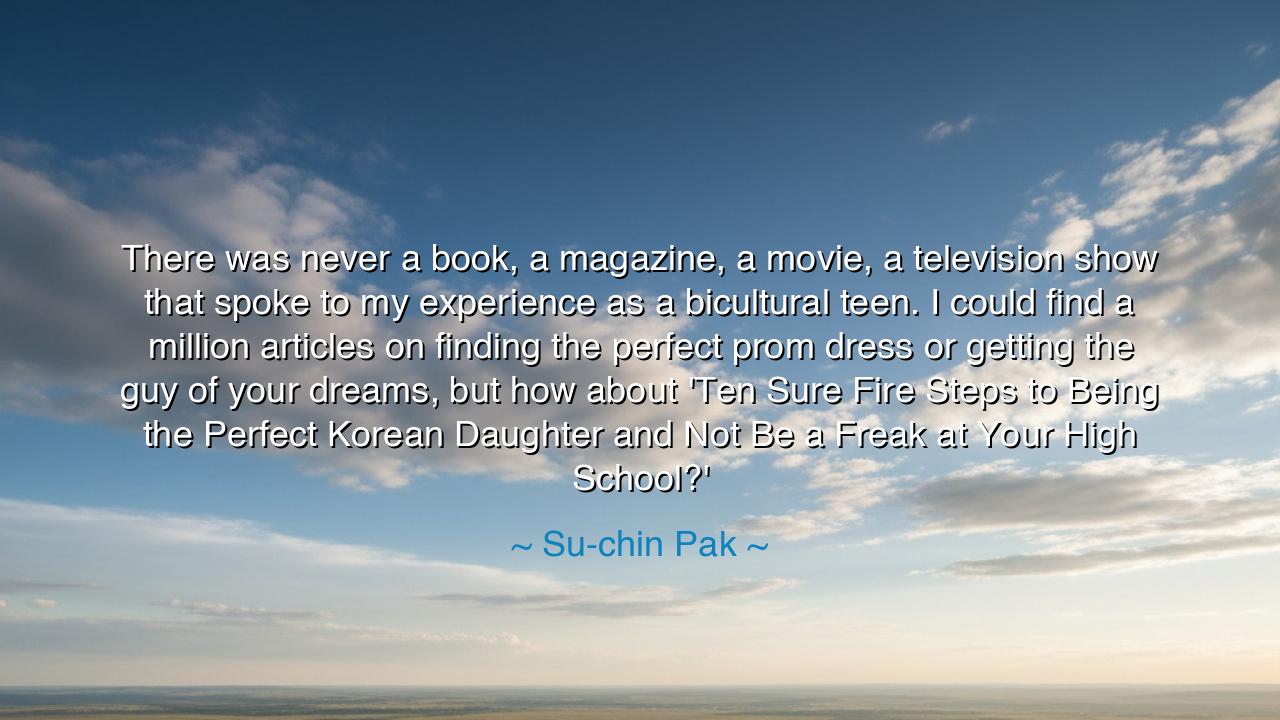
There was never a book, a magazine, a movie, a television show
There was never a book, a magazine, a movie, a television show that spoke to my experience as a bicultural teen. I could find a million articles on finding the perfect prom dress or getting the guy of your dreams, but how about 'Ten Sure Fire Steps to Being the Perfect Korean Daughter and Not Be a Freak at Your High School?'






When Su-chin Pak declared, “There was never a book, a magazine, a movie, a television show that spoke to my experience as a bicultural teen. I could find a million articles on finding the perfect prom dress or getting the guy of your dreams, but how about ‘Ten Sure Fire Steps to Being the Perfect Korean Daughter and Not Be a Freak at Your High School?’” she gave voice to the ache of invisibility—the pain of living between worlds without seeing oneself reflected in the stories of the age. Her words are both lament and revelation, for they remind us that culture, when it fails to include, silences not just individuals, but entire generations longing for recognition.
The origin of this reflection lies in the experience of growing up bicultural: carrying the traditions, expectations, and heritage of one culture while navigating the pressures and norms of another. For Pak, the struggle was not simply about adolescence itself, but about the double weight of living as a Korean daughter bound by family duty while also trying to survive the rites of American high school. The glossy magazines and cheery television shows offered endless guidance on fashion and romance, yet they were mute on the struggles of reconciling parental expectations with peer acceptance. Her words expose a gap—a silence in the cultural mirror that left her and many like her unseen.
This silence has been echoed throughout history by countless groups who searched for themselves in the dominant narratives and found only absence. Consider the African American writers of the Harlem Renaissance, who spoke of the frustration of being excluded from mainstream literature, creating their own art to declare: we, too, are America. Or recall the early feminist writers, who noted that women’s lives were absent in the great works of philosophy and history, forcing them to write their own truths into existence. In the same way, Pak points to the absence of bicultural teens in the media of her youth, reminding us that invisibility is a wound that can only be healed by new stories being told.
Her mention of the perfect prom dress and “getting the guy of your dreams” is more than an observation; it is a symbol. These were the pillars of the stories offered to her, the narrow scripts of belonging that revolved around beauty, romance, and assimilation. But where were the guides for those balancing filial duty with individual freedom? Where were the scripts for those who had to translate between two languages at home and then stand unmarked among their peers at school? In their absence, she was forced to invent herself in solitude, without cultural signposts to guide her.
The deeper meaning of her words is this: representation is not a luxury, it is a necessity. Without it, young people grow up feeling alien, fractured, and alone. The soul hungers to see itself reflected, to be told that it belongs not only in private but in public, not only in the household but in the shared imagination of society. When culture fails to provide such reflections, the burden falls on individuals to navigate their struggles in silence, often believing that their difference is a flaw rather than a richness.
The lesson, then, is profound: we must tell the stories that have not yet been told. If you carry the experience of being unseen, you have within you the power to give voice to others who walk the same road. The books unwritten, the shows unproduced, the stories absent—these are not voids to despair over but invitations to create. In naming what was missing, Su-chin Pak reminds us that silence can be broken, that the next generation deserves to find themselves on the pages, on the screens, in the songs of their time.
Practical wisdom follows. Seek out and support diverse voices—authors, filmmakers, and storytellers who widen the cultural lens. If you are one who has felt unseen, dare to write, to speak, to create, for your story may be the guidepost another soul desperately needs. And for parents and mentors: honor the complexity of bicultural teens, recognizing that they are not divided but enriched by their dual heritage. Help them weave their identities into strength rather than shame.
Thus, Su-chin Pak’s words rise as both a critique of the past and a beacon for the future. They remind us that every culture must continually broaden its stories, for each new generation brings lives that do not fit neatly into the old scripts. And so the teaching is eternal: do not leave the young to search in vain for themselves. Give them stories where they are heroes, where they are seen, where they belong. For in seeing themselves reflected, they will learn not to feel like “freaks,” but to walk with pride in the fullness of who they are.






AAdministratorAdministrator
Welcome, honored guests. Please leave a comment, we will respond soon